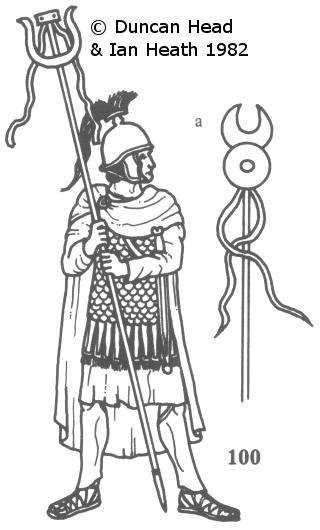
CARTHAGINIAN OFFICER WITH STANDARDS
An extract from Armies of the Macedonian and Punic Warsby Duncan Head, illustrated by Ian Heath
100. CARTHAGINIAN OFFICER WITH STANDARDS

This man’s helmet and standard are from a crude and incomplete carving of a horseman sometimes called "the stele of the Punic Mars" which has been dated to the time ofthe wars with Rome. The helmet has a conventional classical crest, but its large crest-knob, bell-shaped skull and thick rim indicate that it is of the Celtic Montefortino type. This was so common in the Western Mediterranean, used in Gaul, Spain and Italy, that it must almost inevitably have found its way into the Carthaginian army, as H. Russell Robinson suggested. Silius Italicus mentions scale armour for officers, and also mentions senior officers at least resplendent in purple and gold; Polybios confirms purple-clad generals. While Silius is often rejected as an historical source, and certainly throws generous amounts of myth, fantasy and rhetoric into his narrative, many of his references to armour and equipment can be confirmed from other sources, and he may have used reliable sources for such "local colour". He also mentions red, yellow and white helmet crests in the Carthaginian army; some helmets have feathers, some have more than one crest.
The standard this figure carries is from the "Punic Mars" stele. It has been described as a ring, but there is a clearly visible break at the top; it seems in fact to be a crescent, with the ends slightly turned out, and with a separate short crossbar to which the dangling ribbons are probably attached. 99a, from a relief of a Carthaginian warship, adds a sun-disc to the lunar crescent; this was common Punic religious symbolism. The standard is also shown, sometimes without the ribbons, on a number of grave stelae.
There are also references to Carthaginian trumpeters. One stele from Cirta shows an instrument like the Roman cornu (see figure 141) which is probably the trumpet meant.